Holland
![]()
This article is about the Dutch region. For other meanings, see Holland (disambiguation).
Holland is a part of the Netherlands bordered by the North Sea to the west, the IJsselmeer and the provinces of Utrecht and Gelderland to the east, and the provinces of Noord-Brabant and Zeeland to the south. Holland, which was also a political entity for a long time as the county of Holland, has been divided between the provinces of Noord-Holland and Zuid-Holland since 1840. The northern border lies at Den Helder and the island of Texel, the southern border in the delta of the Rhine, Meuse and Scheldt. Holland is home to the major cities of The Hague, Rotterdam and Amsterdam, among others, which are part of the Randstad conurbation. In the west, at the North Sea, there are mainly dunes along the coast, inland there are flat polders. Most of Holland lies below sea level.
In German colloquial language, likewise in the colloquial language of other countries, and also by many Dutch people themselves, the term "Holland" is often used pars pro toto for the "Netherlands". This usage started with the beginning of the 17th century, when the province "County of Holland" became the most influential province of the Republic of the Seven United Provinces. This marked a change in international usage, as until the end of the 16th century the country was known more by the name "Flanders" to trading partners abroad. The provinces of "County of Flanders" as well as "Duchy of Brabant" were household names abroad, as they were the country's most active provinces in international trade until the late 16th century. The province of the "County of Holland" as well as the "Republic of the Seven United Provinces" were only able to develop in international overseas trade and build up an international reputation after a trade embargo weighing on the country between 1585 and 1608 was lifted.
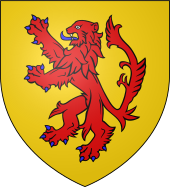
Coat of arms of the county of Holland
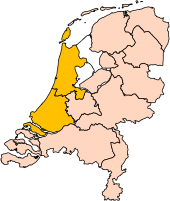
The provinces of Noord-Holland and Zuid-Holland in the territory of the Netherlands
History
→ Main article: History of the Netherlands
The area was part of the Roman Empire for a few years under Augustus as Germania magna. After centuries of Frisian independence, it then became part of the Frankish Empire and the subsequent Holy Roman Empire. In 1384 it came under French influence (Burgundian Netherlands). In 1430, the County of Holland finally came by inheritance to the House of Valois-Burgundy and, after the death of the last Burgundian Duke Charles the Bold in 1477, to the House of Habsburg, later to the Spanish line of the Habsburgs (Spanish Netherlands).
From 1581, the County of Holland was the leading province of the Republic of the Seven United Provinces. During the Napoleonic period there was the Kingdom of Holland (1806-1810), which comprised what is now the Netherlands. In order to reduce the dominance of Holland, which was the main cultural, political and social part of the country, it was divided in 1840 into what are now the two provinces of Noord-Holland and Zuid-Holland.
The name Holland was first mentioned in 866 as Holtland ("woodland" or "forest land") for the area around Haarlem.
· 
Roman provinces with the adjacent Germania magna
· 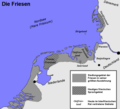
The historical settlement and language area of the Frisians
· 
The expansion of the Frankish Empire 481 to 814
· 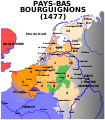
Burgundian Netherlands around 1477
· 
United Netherlands around 1648
· 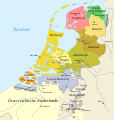
The Seven United Provinces
· 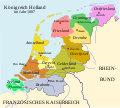
Kingdom of Holland 1806-1810
See also
- Provinces of the Netherlands
- List of the Counts of Holland
- List of Council pensioners
Search within the encyclopedia